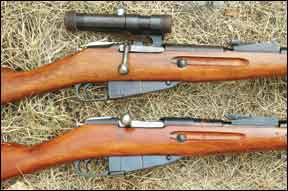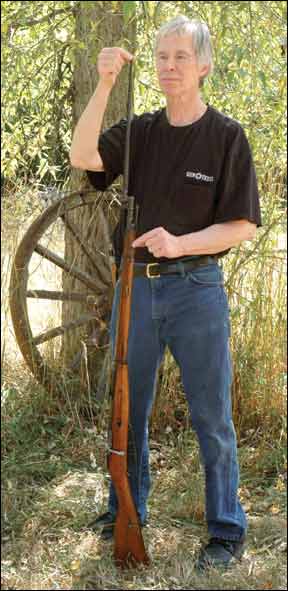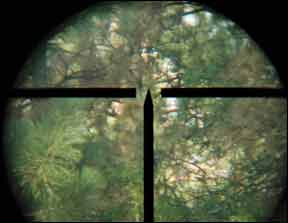The ancient Mosin Nagant rifle has a storied history. It was the first magazine rifle adopted by Russia, back in 1891. The early versions harked back to Civil War rifles as to overall length. The first version of the rifle was over 50 inches long, and by 1930, as with our test rifles, the length is still over 4 feet. Add a bayonet and the gun resembles a spear more than a modern rifle. However, the basic design is still being used by many troops who need a stout bolt-action rifle, well over a century after its introduction. The Mosin Nagant will never win any beauty contest, mostly because of its drop-down magazine, and we don’t know of any custom sporters built on them, though they surely exist. However ugly the rifle may be, it has served long and well as a prime military weapon.

In this report we tried to find out how good a military rifle the 1930 variant was, and if it was any better with a scope. To that end, we acquired two of the long Model 1891/30 rifles, which designation indicates the original design was seriously modified in 1930. One of our test rifles was a common variety and the other, the “sniper” version with a reproduction period scope. The two rifles came with a package of bayonet, sling, and cleaning materials. We tested them with three bullet types and weights, 150-grain soft-point boattail, 182-grain FMJ BT, and 203-grain soft point. The first two types of our test ammo were made by the Serbian Prvi Partizan company, and the third by Brown Bear, out of Russia. Here’s what we found.
Mosin Nagant 1981/30 Rifle 7.62x54R, ~$140
We thought this rifle looked just great. It may have been arsenal refinished, because in many ways it looked like new, but had a few minor nicks and scratches here and there. It was full of grease when we got it, and even the bayonet was all greased up. Imagine a 4-foot-long rifle, and then stick a bayonet on it. Watch out for the ceiling! The rifle felt tight and a bit stiff as though it were new. The wood looked really nice, with sharp edges to the grooves, and with nice bluing on the butt, trigger guard, and in fact on all the metal pieces. We’ve seen some offers of this rifle for less than $100, and if they’re in this kind of condition, you can’t buy a better piece of firearms history anywhere for less money.
The bands that held the wood stock to the metal were all tight, crisp and newly blued. Close inspection revealed old marks partially buffed or ground away, leading us to suspect they were indeed refinished. Yet the action and barrel retained the original machining marks from manufacture, with no over-buffing. The action was apparently broached, with lots of chatter marks. Some information may have been ground off. The profile cuts in the action held coarse milling marks. The original barrel-turning marks were clearly visible all the way to the muzzle. The markings stamped into the barrel breech were crisp and clean. All the red-filled numbers matched wherever we found them, barrel, magazine bottom, butt plate. At any rate, the rifle was in outstanding condition. The barrel appeared to be new inside as well. Even the magazine interrupter worked to perfection, and these are said to be not all that reliable.
The bolts of these rifles are fascinating, and very machining-intensive. They consist of six main parts, all but one readily taken apart for easy replacement, just what you’d want in a military rifle. The exception is the extractor, which we didn’t try to remove. It appeared to come off to the rear by being driven out from the front. It was rather small, resembled the modern Sako extractor, and worked inside a recessed bolt face. Yes recessed, so when you see a modern manufacturer touting his “band of steel” surrounding the head of the cartridge, tell him it started at least as far back as 1891. The bolt handle was short — too short, we thought — and stuck straight out to the side. Unlike most modern rifles, the bolt lugs locked into recesses in the side of the action, not the top and bottom. The short bolt handle made it somewhat of a chore to force the extractor over the cartridge rim and to work the bolt to extract a fired case. If you had a case stick, you’d be in trouble with the short handle, we thought.
With our preliminary inspection done, and with all the grease taken out of the rifle, we took it to the range and began with the 150-grain bullets. The Russians adopted the 150-grain spitzer bullet early in the 20th Century, and we expected best results with that bullet weight. We fired at 50 yards, wanting to give the iron sights a better chance of showing us what the rifle can do than if we had fired it at 100. We had tightened the two screws holding the action into the stock. By the end of the test the screws were both loose, so bear in mind we might have been able to get better accuracy out of this than we did. We commonly had two shots touching at 50 yards, with the third about an inch away. Awesome! The 150-grain ammo came out of that long barrel at 2830 fps, despite one set of original ballistics in our files that gives an expected velocity of around 2650. The barrel got extremely hot during our shooting session, and we were not hurrying. However, outside temperature was in the mid-90s, and that didn’t help the heat factor. As expected, our best results for regulation and accuracy were with the 150-grain ammunition, though the 182-grain stuff was not far behind. The 203-grain ammo struck 6 inches high at 50 yards, and the groups were the largest of the three ammo types.
We had an occasionally sticky bolt, but it was not so bad as to be a concern. A few rounds occasionally required a slight thump on the bolt to get it open. Extraction, ejection, and feeding were all flawless. We had some trouble getting the rounds into the five-round magazine, but that was just our unfamiliarity with the system. The rifle had a notch for stripper clips, but there was no room for the thumb, as on the Mauser 98. This setup would be a good recipe for ripping off the thumbnail, we figured. The bolt was a touch rough in its operation, and remained so for our test. We noticed a tendency of the bolt handle to move slightly as we pressed the trigger. The trigger pull was not bad, two stage, with about 5.5 pounds for the first stage, and a somewhat rough and slightly unpredictable final pull of about 6.5 total. We liked the iron sights. The front was a flat-top post well protected by a hood. The hood and post were a unit dovetailed into a transverse slot for windage tweaking. The rear was a ladder, or tangent sight, adjustable out to a whopping 2000 yards. Its notch was well matched to the front, and there was a good flat line to the top of the rear blade, which gave an excellent sight picture. We far preferred this to the

sharp-topped sights typically seen on the Mauser 98.
We thought the rifle was well balanced, despite its length. The barrel was slim enough that the major mass of the rifle was between the hands. This made for lively handling, yet the great length of the barrel was enough to steady the rifle to give good results offhand. We did not shoot the rifle with the bayonet attached. In fact, its fit was tight enough that it would have required some fitting to let it snap into place. But it would be a great addition to the piece for wall display, we thought.
We thought that if we had to become very familiar with the rifle and rely on it, its function would easily become more natural for us. One item that we found fascinating was the interrupter within the magazine that prevented double feeding. If you began to chamber a round, but didn’t close the bolt for any reason and somehow the bolt managed to get fully rearward, with most modern rifles you’d have a huge double-feed jam to clear before you could get back into operation. Not so the Mosin Nagant. The upcoming round in the magazine was positively prevented from rising by the interrupter, until the bolt could be closed over the chambered round and the extractor snapped over its rim. Only then does the interrupter permit the next round to rise against the bolt. This system was apparently not too reliable with any sort of abuse, and in fact it had failed on the other test rifle. But we liked it, and it’s a fascinating bit of machinery. Another item was the “safety” feature. With a round chambered and the rifle cocked, you could pull rearward on the cocking-piece extension and rotate it to the left, which essentially tied up all the operations of the rifle that were necessary for it to fire. We found it nearly impossible to apply, because to do so required overpowering the strong firing-pin spring.
Our Team Said: In the end, we felt this whole rifle system was well worthy of study, and when you can get one in this kind of condition for the very low price asked, we simply have to say it’s a Best Buy.
Mosin Nagant Sniper
Model 1891/30 7.62x54R, ~$500
This version of the old rifle had a thick steel plate screwed and pinned to the left side of its action. This plate was the mount for the telescopic sight that came in the package. The forward portion of the mount was essentially half a ball that accepted the hole in the front of the scope’s base. The rear portion of the base had a large thumbscrew coming in at an angle to force the rear of the scope’s base securely against the mount. In addition, there were opposing screws in the scope base that permitted setting the zero of the scope’s elevation to align with the scope’s own zero setting.
The other alteration to the rifle was the addition of a long, bent bolt handle that allowed operation of the bolt with the scope attached to the rifle. In most other ways it resembled the first rifle tested, but it didn’t have the crisp, new look. Areas where it had been redone were obvious, such as the rear portion of the barrel. It had none of the original machining marks present, nor were there any on the barrel near the muzzle. There was a new serial number stamped in the barrel, the floorplate, the bolt, the butt plate, and the scope that came with it, but oddly not into the action. That had a totally different number, the one we used for I.D. with our FFL holder.
The rifle resembled the other one in all respects, full-length wood top and bottom on the barrel. By the way, the bottom portion of the stock on both rifles was a single piece of lumber nearly 4 feet long, and it appeared to be good clear birch. Both rifles had the screw-in ramrod beneath the barrel. Sorry, make that a cleaning rod, not ramrod. Still, that term harks back to the early 1800s when the so-called ramrod under the muzzleloader’s barrel was generally referred to by the mountain men as a wiping stick. These rifles had sling-attach points that amounted to slots through which you could thread the leather ends of the slings that came with them.
Getting back specifically to our sniper rifle, this one appeared to be a whole lot more tired than the other rifle. The scope that came with it was heavy and crude by modern standards. It was newly made of steel, and its base was formed of milled, quarter-inch thick steel. Nothing delicate here. The scope had sewn, leather,

protective covers that were joined with a strap that passed through the scope mount, and were thus with the scope forever. Yes, they got in the way terribly during our testing. The lenses were uncoated. We wondered where anyone, even in Russia, could get uncoated optics today. A sheet of paper that came with the telescopic sight indicated it was 4X, had been manufactured per the original documentation of 1928, and had been made in 2008. What you saw peering through this sight was two opposing posts with a third, vertical, “picket fence”-type sighting post in the middle. The two side elements were on the same level as the tip of the sighter, and with the scope’s external adjustment turned to zero, the entire sight picture was up at the top of the field of view. As you dialed in more range (approximately 1400 meters) the sight “picture” moved down in the scope’s field of view and ended up near the bottom. This seemed strange at first, but actually made good sense. It gave you good, instant feedback about where your adjustments were at any given time. The windage adjustment also moved the picture, i.e., the central picket, bodily side to side. We found these adjustments entirely too easy to bump and change, especially when working the bolt, but that was the least of our problems with this setup on this rifle.
We mounted the scope, guessed at the elevation and tightened the opposing screws to give us a start on how to set the scope. We thought we had everything good and tight, and then went to the range to bore-sight the system. That done, we began our aggression against the target with the 150-grain ammunition. With the first shot the scope became loose, so we tightened it and shot again. No bullet on the large paper at 50 yards. The scope was again loose. We were single-loading the rifle at the time. We again bore-sighted it and started over. Bang. On target, but scope was loose yet again. We had enough of that, and secured the scope with a leather pad over the thumbscrew, and a large pair of pliers. Crude, but very effective. The scope no longer came loose, but our best groups were on the order of five inches at 50 yards. The more we shot, the more problems we had, which we thought were with the scope. In frustration we removed the scope and shot the best groups with that rifle we had yet produced. By this time we had taken to shooting from a full magazine. We quickly found the rifle would not eject, and would not feed properly either. We found the interrupter did not work at all. By the end of our evaluation our best group had been with the heaviest ammunition and iron sights, 1.3 inches, but it was 9 inches above the point of aim at 50 yards with the rear tangent sight as low as it would go.
Our Team Said: We don’t know if our problems were universal, but we would not recommend acquiring this rifle unless you want it solely as an example of an early sniper rifle, and could be content to not shoot it, or shoot it very little. It was not fun to shoot, malfunctioned frequently, and got us cursing as few rifles ever have. Yet it is certainly an interesting rifle, and it may be that your results with a different sample will be much more successful than was our experience. We gave this one a D. It had potential, but just didn’t do what it was designed to do.





























